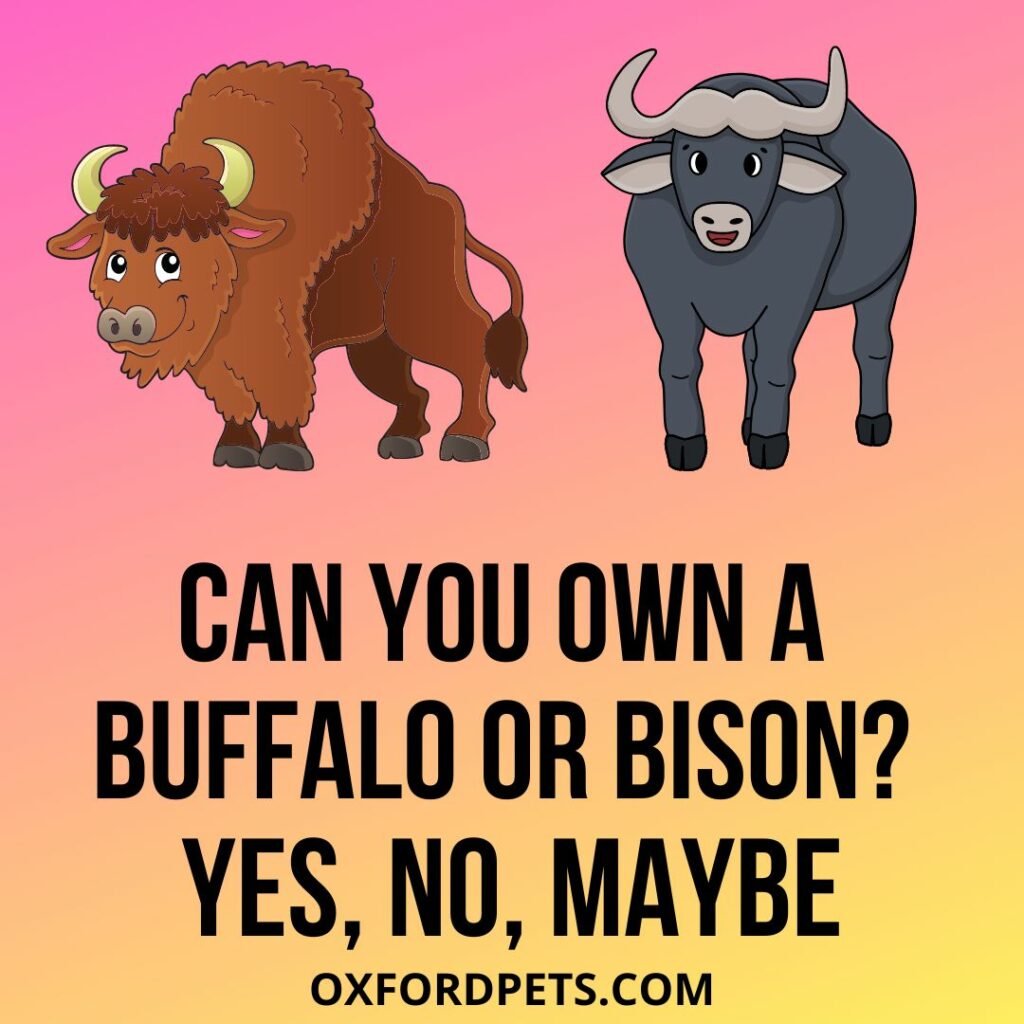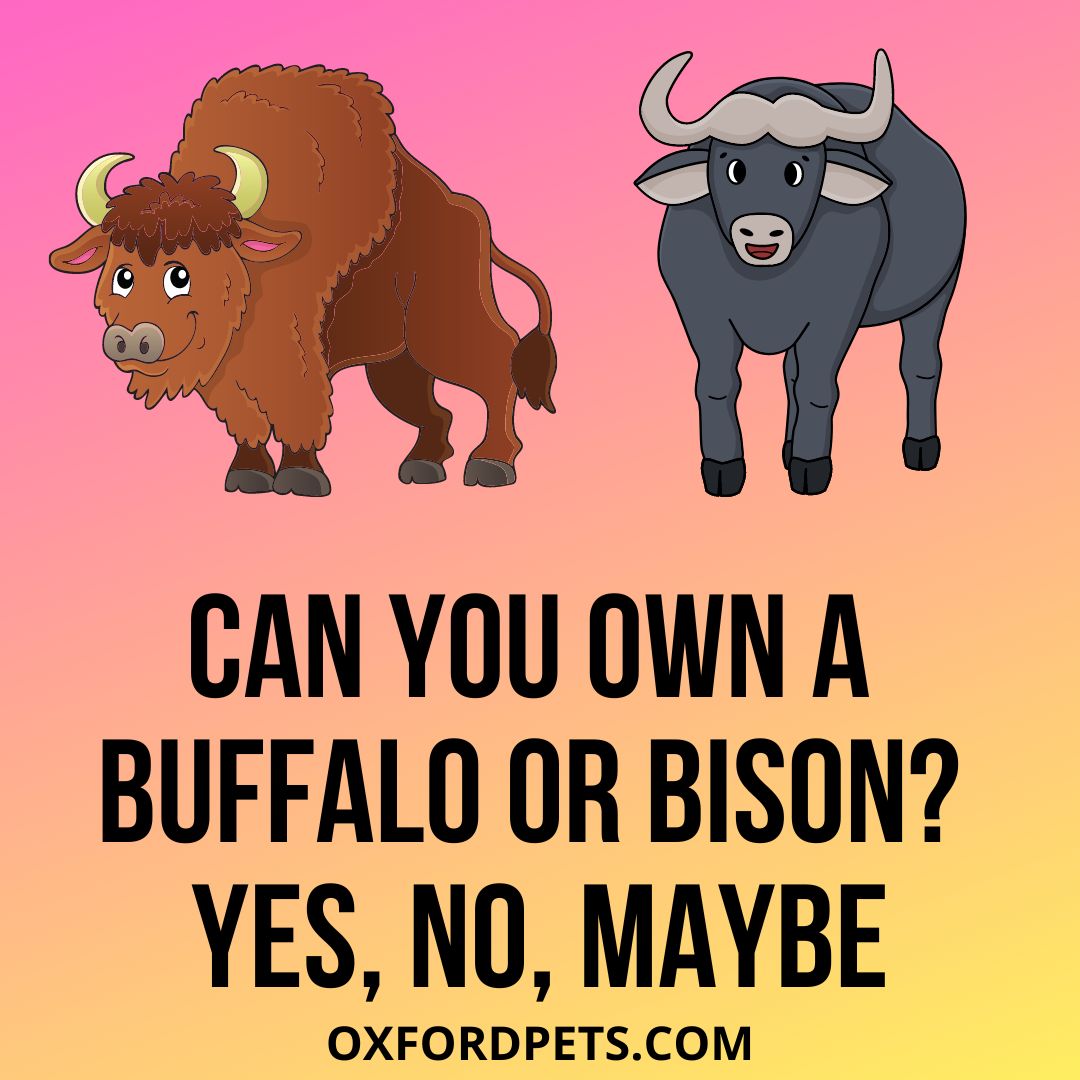Does the idea of keeping a Buffalo or Bison as a pet excites you? Wondering if you can own a pet Buffalo in your backyard? Well, if your fascinations are similar, you may end up with some positive news. Make sure you read through the article till the end and get the most out of it.
Contents
- Getting a Pet Buffalo or Bison: What You Need to Know
- The Difference between Buffalo and Bison
- Where are the Buffalo Origins?
- Where Do bison Evolve from?
- Buffalo and Bison Species Taxonomy
- Do Buffalo or Bison Make Good Pets?
- Is It Legal To Keep Buffalo or Bison As A Pet?
- Are Bisons and Buffalos legal in the US?
- Keeping Buffalo and Bison as Pets- You have to meet their needs
- Frequently Asked Questions
- Wrapping up…
Getting a Pet Buffalo or Bison: What You Need to Know
So, What is a Buffalo or Bison? Buffalo is a wild as well as a domestic animal that belongs to the Bovidae family. Their species include three different types, the Wild water buffalos, the Anoas, and the African Buffalos. Another species known as water buffalo is often used for domestication.
Buffalos are common in South Asia, South East Asia, and Sub-Saharan Africa. However, one can also find a few varieties of them in parts of Europe and North America.
Whereas Bison is a different animal, though it too belongs to the Bovidae family. Their species include two extant and multiple extinct. The two commonly surviving amongst them are the American Bisons and the European Bisons.

The Difference between Buffalo and Bison
- Bison are native to North America and parts of Europe. They are also known as the largest surviving terrestrial animals in North America and Europe.
- Buffalos and Bison are only distantly related to each other. Though people in parts of America often confuse and refer to Bisons as Buffalos, in reality, they are quite different. Here are some of the common differences one can closely observe between the two:
- Both have very different physical appearances. Bison are larger, heavier, and have bigger heads, whereas Buffalos have smaller heads and shoulders than the rest of their bodies.
- Bison are native to parts of Europe and North America. In contrast, Buffalos are found in Asia and Africa.
- Bison have short, relatively slender horns a few inches above their eyes. Whereas Buffalos have comparatively wider horns that grow sideways out of their heads before curving.
- Bison have a shabby winter coat, whereas Buffalos have thin hair. The former shed their fur/ hair during the summer season but later keep it year-round.
Where are the Buffalo Origins?
Buffalos are known for coming down in the western part of India. They were and are continued to be domesticated here for over 6,300 years now.
Some studies also believe that Buffalos were domesticated about 3,000 to 7,000 years ago in and around Mainland Southeast Asia.
Where Do bison Evolve from?
Bison, too, are known to appear in the Asian region about 2.6 million years ago in the Early Pleistocene.
In North America, they are known to arrive during the Middle Pleistocene period, about 195,000 to 135,000 years ago.
As researches suggest, Bisons descending from the Siberian Steppe Bison.
Buffalo and Bison Species Taxonomy
| Name | Bison | Buffalo |
| Scientific Name | Bison | Bubalus bubalis |
| Kingdom | Animalia | Animalia |
| Phylum | Chordata | Chordata |
| Class | Mammalia | Mammalia |
| Order | Artiodactyla | Artiodactyla |
| Family and Subfamily | Bovidae and Bovinae | Bovidae and Bovinae |
| Fur | Thick and shedding | Light and non-shedding |
| Size | Up to 6 feet About 700 to 2,200 lb. | Up to 5 feet About 1870 to 2640 lb. |
| Lifespan | 13 to 21 years | 15 to 30 years depending upon the subspecies |
| Native | North and South America, Europe. | Asia (Water) and Africa (Cape). |
| Population | 2 million. | 160,000 (Cape) 150 Million (Water) |
| Domestication | No | Yes a few species |
| Habitat | Rugged lands, plains, and cold places | Plain and Rugged lands depend upon the subspecies. |
Do Buffalo or Bison Make Good Pets?
Buffalos, especially Water Buffalos, make great pets, and their domestication is common in the Nile and in Asia. The Cape Buffalos, on the other hand, are wild and slightly difficult to pet.
Since they are tamed, individuals petting them never know what wild is going to come their way. That is why Water Buffalos always makes better and safer pets than Café Buffalos.
Whereas, Bisons also are known for domestication but tend to make poor pets. They retain a lot of wild behavior and are usually ready to fight and attack if they feel threatened. Bison are usually calm animals, but if their tail is standing straight up, they are ready to charge.
In short, both Buffalo and Bison are known for domestication though the latter does not make good pets.
Is It Legal To Keep Buffalo or Bison As A Pet?
Yes, it is legal to keep Buffalos and Bisons as pets in most parts of the world.
Even countries like India, Pakistan, and other parts of the Indian Subcontinent have a long-time tradition of domesticating Buffalo, Cows, and even Bisons.
The practice commonly comes into the light for dairy farming, meat, and pastoral farming.
Are Bisons and Buffalos legal in the US?
Bison and Buffalos are legal in major parts of the United States. States like Alaska, Arizona, Montana, Utah, and Wyoming legally classify and manage Bison as wildlife. Whereas, in other states, both Bisons and Buffalos are legal to be kept as pet animals.
However, shooting and killing Bison is still illegal in most parts of the United States. For doing so, one needs to gain a hunting permit from State Park or another reputed association.
Today there are Bison and Buffalos present in almost all the 50 states. Both of these animals are used for hunting, meat-eating, fur trade, skin (leather trade), and more.
Keeping Buffalo and Bison as Pets- You have to meet their needs
Buffalo and Bison Housing Needs
Keeping Buffalos and Bison as pets is easier than one thinks. Since their housing needs are extremely sorted out, almost even a novice can keep them as pets.
For keeping Buffalos and Bison as a pet, one needs at least 1 acre of grassland. Though in many parts of the world, people also keep Buffalos on concrete floors and limited space, though having something more natural and bigger is better. A grassland allows the animal to graze and roam around freely.
The next step is to cover the land with either metal wiring, or high concrete walls. It will help keep the animals free and will also save them from possible theft. There is, though, no need to cover the area from above. However, make sure you build a shaded section for the animal to rest during the sparkling sun and night hours.
Buffalos and Bisons’ Temperature & Humidity Needs
Both Buffalos and Bison are survivors and can handle different types of climatic (temperature and humidity) conditions.
As long as they are getting the right amount of food, water, and shade, the heat won’t necessarily affect them.
Similarly, Buffalos and Bisons even have a greater tolerance to cold weather as well. The latter of them even can handle snow conditions and temperatures minus.
Buffalos and Bisons’ Dietary Needs
Both Buffalos and Bison are grazers, and their dietary need is as simple as grass. Buffalos’ main diet is roughage such as grass, legumes, and straw. Bison, though, are most likely to eat grass all their life, but they will occasionally love having berries and lichen.
Buffalos eat 2.2 to 2.5% of their live weight per day. A milk-producing Buffalo will eat more, likely 3% of its live weight per day. At the same time, a Bison eats 1.6 % of its body mass per day, which probably counts as 24 lbs.
Buffalo and Bison Cleaning
Keeping Buffalo and Bison as pets likely brings a lot of responsibilities as well. For example, cleaning their area almost every two days, especially with all their digestive waste, is necessary.
Besides that, bathing the pet animals once in a while is something every caretaker should consider about.
Common Health Problems with Buffalo and Bison
Common health problems that Buffalos suffer from include Leptospirosis, brucellosis, Bovine Tb, BVDV, and fasciolosis. Johne`s disease is another chronic contagious enteritis in Buffalos.
Common health problems Bison suffer from Mycoplasma Infection, Pink Eye, Malignant catarrhal fever (MCF), etc.
How much does a Buffalo or Bison cost?
A Buffalo can cost anywhere between $768.94 to $1500. At the same time, a Bison costs somewhere between $5000 to $10000.
Where to buy a Buffalo or Bison? Where to find a Buffalo or Bison Breeder?
The best place to buy a Buffalo or Bison is on farms, livestock markets, and auctions. Today even online websites help in buying and selling cattle like Buffalos and Bison.
However, since most Buffalos and Bison are far away in North America, people in other regions might have a hard time getting their hands on one.
Individuals also breed cattle like Buffalo or Bison and sell meat-bearing, milk-bearing, and other animals used for commercial purposes.
Frequently Asked Questions
Are Bisons friendly?
No, Bison aren’t friendly at all. If their sight is aiming at you, it is because the animal is curious. The chances are that they are planning to attack you in a short while.
How many acres do you need per Bison or Buffalo?
To accommodate one Bison, you will need at least half to one acre of land.
Bison vs Buffalo- Who is easier to raise?
Buffalos are undoubtedly easier to raise than Bisons. It is since the former is most of the time calm and does not make it a hell of individuals. However, Bisons, at the same time, are aggressive and tamed and can prove threatening to humans.
Is Bison or Buffalo meat healthier?
Yes, Bison or Buffalo meat is extremely healthy with more percentage of protein and less percentage of cholesterol. There are only 3 grams of fat in 3 ½ –an ounce serving of buffalo sirloin. Also, American Bison has between 15 and 30 percent more protein than beef and many other similar meat-producing cattle.
- Can You Legally Own a Pet Jaguar?
- Is it Legal to Own a Pet Coatimundi?
- Can You Own a Pet Kinkajou? Yes Or No?
Wrapping up…
If your fantasies for keeping pets are beyond dogs and cats, then Buffalo or Bisons are some great domestic animals for you.
However, remember to maintain distance with the pets no matter how quiet they appear. Especially with Bisons, you never know when it might attack you and leave you all bruised and broken.
